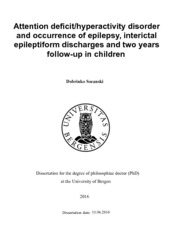| dc.contributor.author | Socanski, Dobrinko | en_US |
| dc.date.accessioned | 2016-07-01T11:32:36Z | |
| dc.date.available | 2016-07-01T11:32:36Z | |
| dc.date.issued | 2016-06-15 | |
| dc.identifier.isbn | 978-82-308-3277-6 | en_US |
| dc.identifier.uri | https://hdl.handle.net/1956/12229 | |
| dc.description.abstract | The detection and treatment of both attention deficit/hyperactivity disorder (ADHD) and epilepsy in young patients are challenging. In some cases, the occurrence of interictal epileptiform discharges (IEDs) flowers the picture, and some clinicians are reluctant to use methylphenidate (MPH) in such cases. Many studies discussed ADHD in children with epilepsy, but only a few investigated relationships between ADHD, IEDs and epilepsy in children with ADHD. It is unclear whether it is safe to use MPH in children with ADHD and comorbid epilepsy and/or IEDs. Aims: We investigated the occurrence of epilepsy and IEDs on awake EEG at baseline in a large sample of children diagnosed with ADHD. Finally, we studied whether the use of MPH would increase the risk for epilepsy in a 2 year prospective, and whether IEDs at baseline influence the occurrence of epileptic seizures (SZs), the use of MPH and the use of antiepileptic drugs (AEDs). Methods: This is a retrospective chart review of all children aged between 6-14 years diagnosed with ADHD over a 6 year period (2000-2005). First, we examined the prevalence and characteristics of epilepsy in children with ADHD and compared it with a general pediatric population, and initial use of MPH in cases with and without epilepsy. Second, we investigated the occurrence of IED on awake EEG at baseline in all children who performed a routine EEG. The clinical characteristics of ADHD children (ADHD inattentive subtype, comorbidities) in cases with and without IEDs were analyzed. Finally, we compared the patients with IEDs (IEDs group) with matched controls (age and gender) without IEDs (non- IEDs group) in a 2 year follow-up. We wanted to examine the use of MPH (initial use, positive response, maintenance on MPH), the use of AEDs, and whether it was safe to use MPH in cases with IEDs (seizure risk) during the first 2 years of treatment. A control EEG was carried out in the IEDs group. Results: We found that 2.3 % of children (N=607) had epilepsy. This is significantly higher than in the general pediatric population (0.5%). In all children, the diagnosis of epilepsy was made before ADHD diagnosis. We were able to carry out baseline EEG in 517 cases and IEDs were found in 39 (7.5%), or in 27 (5.4%), if patients with previous epilepsy were excluded. When we compare this rate with rates of IEDs reported in healthy children, it is unclear whether any differences exist. The cases with IEDs more often had inattentive type of ADHD regardless of previous history of epilepsy. Of the children with IEDs, only children with previous difficult to treat epilepsy developed SZs during the 2 year follow-up, but without any change in SZ frequency. The groups with and without IEDs did not have significant differences in the use of MPH. Some cases from the IEDs group temporarily used AEDs because of diagnostic uncertainties. Conclusions: Epilepsy and IEDs occur more often in children with ADHD compared to the general pediatric population and healthy children. The groups with and without IEDs had similar use of MPH during the two 2 year follow-up. The occurrence of IEDs at baseline was not associated with an increased SZ risk during the 2 year follow-up despite the use of MPH. | en_US |
| dc.language.iso | eng | eng |
| dc.publisher | The University of Bergen | eng |
| dc.relation.haspart | Paper I: Socanski D, Aurlien D, Herigstad A, Thomsen PH, Larsen TK. Epilepsy in a large cohort of children diagnosed with attention deficit/hyperactivity disorders (ADHD). Seizure: 2013;22:651-655. This article is not available in BORA. The published version is available at: <a href="http://dx.doi.org/10.1016/j.seizure.2013.04.021"target="blank"> 10.1016/j.seizure.2013.04.021</a> | en_US |
| dc.relation.haspart | Paper II: Socanski D, Herigstad A, Thomsen PH, Aarsland D, Larsen TK. Epileptiform abnormalities in children diagnosed with attention deficit/hyperactivity disorder. Epilepsy & behavior: E&B. 2010; 19: 483-486. This article is not available in BORA. The published version is available at: <a href="http://dx.doi.org/10.1016/j.yebeh.2010.08.005"target="blank"> 10.1016/j.yebeh.2010.08.005</a> | en_US |
| dc.relation.haspart | Paper III: Socanski D, Aurlien D, Herigstad A, Thomsen PH, Larsen TK. Attention deficit/hyperactivity disorder and interictal epileptifom discharges: it is safe to use methylphenidate? Seizure: 2015; 25.80-83. This article is not available in BORA. The published version is available at: <a href="http://dx.doi.org/10.1016/j.seizure.2015.01.002"target="blank"> 10.1016/j.seizure.2015.01.002</a> | en_US |
| dc.title | Attention deficit/hyperactivity disorder and occurrence of epilepsy, interictal epileptiform discharges and two years follow-up in children | en_US |
| dc.type | Doctoral thesis | |
| dc.rights.holder | Copyright the author. All rights reserved. | |
| dc.identifier.cristin | 1372359 | |
